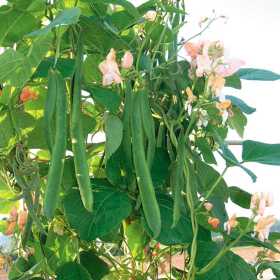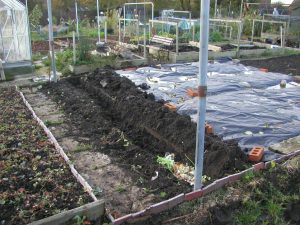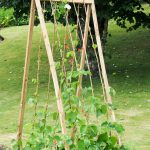How to Grow Runner Beans – A Guide to Growing Runner Beans
 Runner Beans
Runner Beans
Runner Beans are a worthwhile crop, one of the most productive and pretty crops for small spaces. In fact they were first grown for their flowers in Britain and people thought the beans were poisonous! Members of the legume family, they produce their own nitrogen, although they still need some additional fertilizer. They can be successfully grown up a wigwam of canes in a large container (50 cm/20 ins) if fed with liquid tomato fertilizer and watered regularly.
Sowing and Growing Runner Beans
- Sow from early May (indoors) to June.
- Harvest August–October.
- Beans are thirsty plants and this is the reason behind the traditional bean trench. These help a lot if you grow on light soil which doesn’t hold water well.
- In winter, dig a trench 20–30 cm (8–12 ins deep) and a spade’s blade in width. Line it with cardboard or sheets of newspaper, fill with vegetable peelings, covering with soil (to stop vermin) as the layers are added. By May, and planting time, this will have reduced well and will help the soil to retain water over the growing season.
- Start the seeds in pots (one seed per 8 cm/3 inch pot) under glass, or on the window ledge, in early May. You can also sow direct at the base of your canes at a depth of 2.5cm to 5 cm (1-2 ins), 22 cm (9 ins) apart in June.
-
Runner beans are not hardy so plant out after all risk of frost in late May or June. Keep an eye on the weather forecasts and if frost is forecast protect with fleece or newspapers. I’ve found bubble wrap wound around the base of the frame protecting the young plants very effective.
- Runner beans are most often grown up a double row of sticks/bamboo canes with 45cm (18 ins) between the rows. Canes in the rows are 22cm (9 ins) apart and tied at the top to a horizontal support.
- It is easier to build a wigwam or 2. Push 2.4 m (8 foot) canes into the soil at 22 cm (9 in) spacing in a circle tied at the top to create a wigwam.
- Pinch out the growing tip once the plants reach the top of the canes, to encourage bushy growth.
- Water regularly if the weather is dry and feed occasionally with a liquid tomato feed.
- In dry weather spraying the plants with water will help the beans set.
Harvesting Runner Beans
- Harvest regularly to keep the plants productive and pick before the beans become tough and stringy.
- You can leave some pods on the plants to ripen and the ripe beans are tasty used in stews and casseroles. You can also save some to use as seed next year.
- Runner Beans freeze well and there are lots of recipes in which to use them, including chutneys.
Pests and Problems with Runner Beans
- Generally trouble-free, although young plants are at risk from slugs and pigeons; black fly can be a problem as the plants grow.
- The plants are not hardy and will be destroyed by frost, or sit sulking if the weather is cold, so don’t plant out too early.
Varieties of Runner Bean
- Painted Lady and St George are possibly the most decorative varieties, with red and white flowers. There are varieties with pink, white and red flowers.
- If you want large beans, look for varieties described as ‘stringless’.
- Some varieties, such as Enorma, tend to produce larger pods.
- The breeders have crossed French beans with Runner beans and the result is a bean that looks and tastes like a runner bean, but doesn’t need insect pollination to set. Varieties include Firestorm with bright red flowers and Moonlight with creamy white flowers






